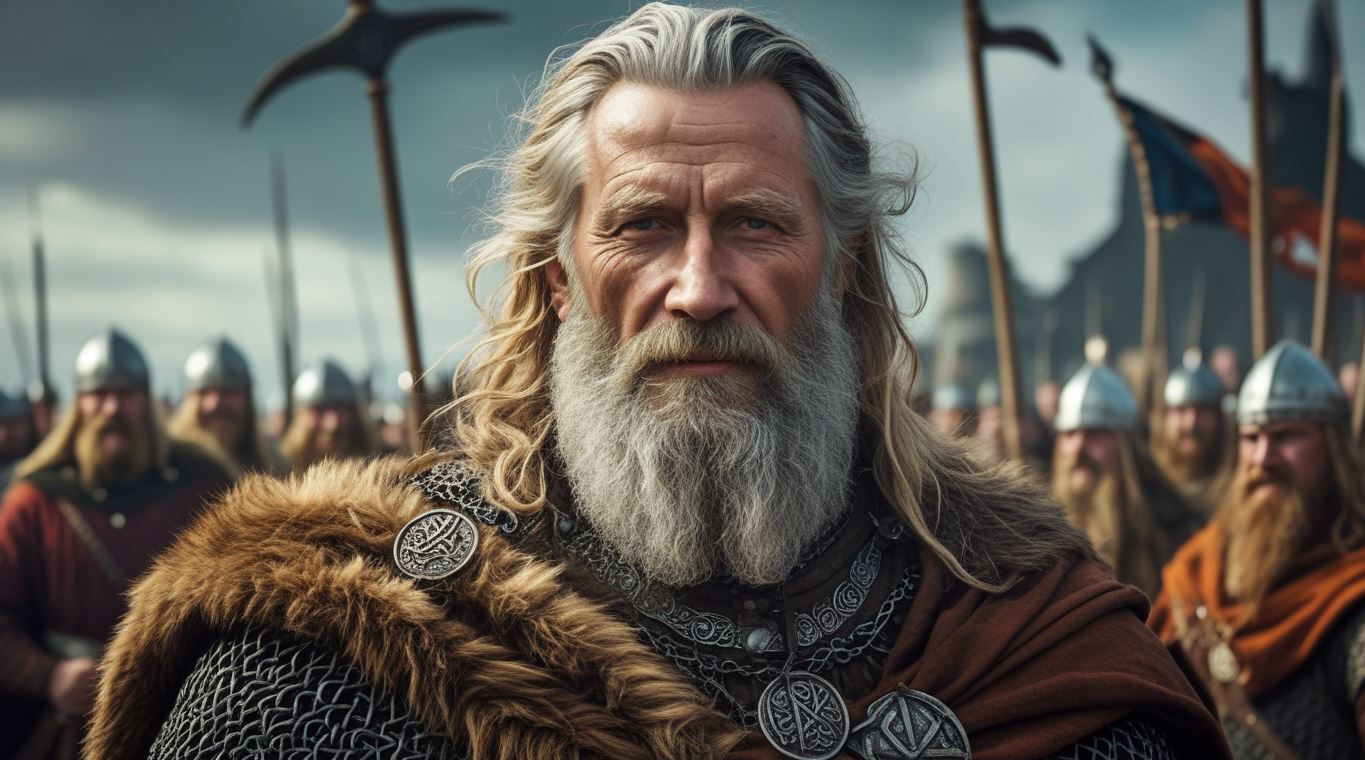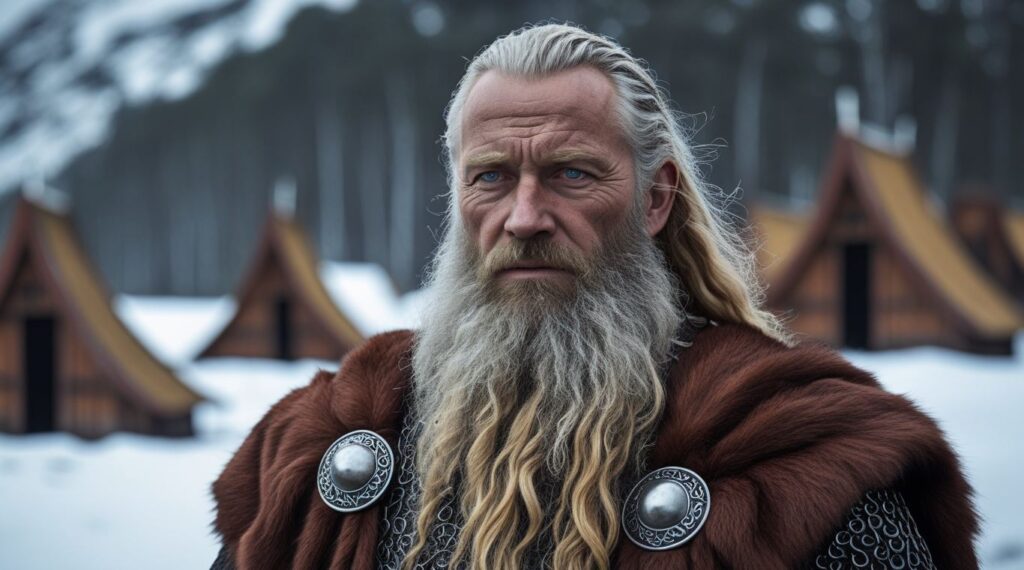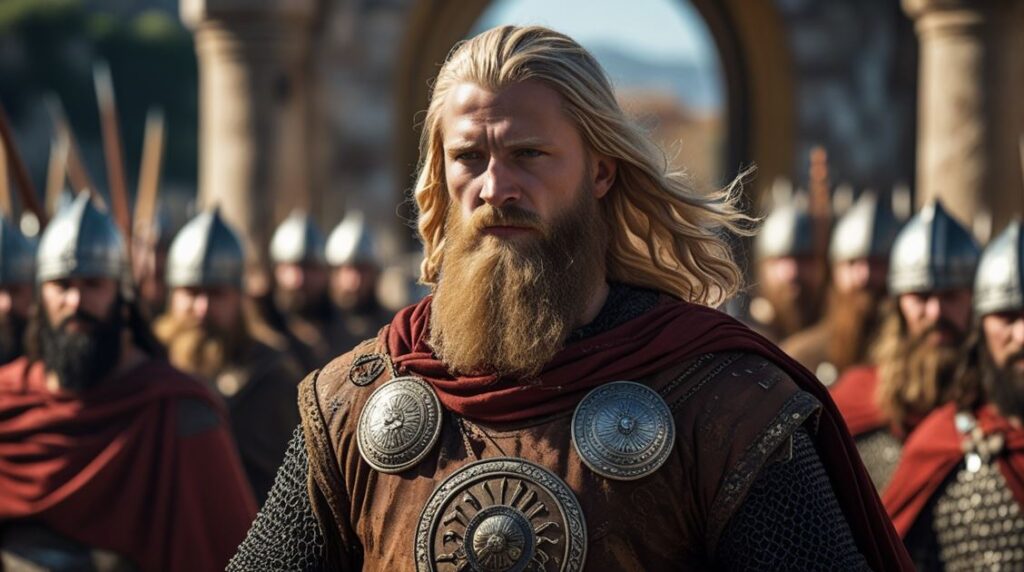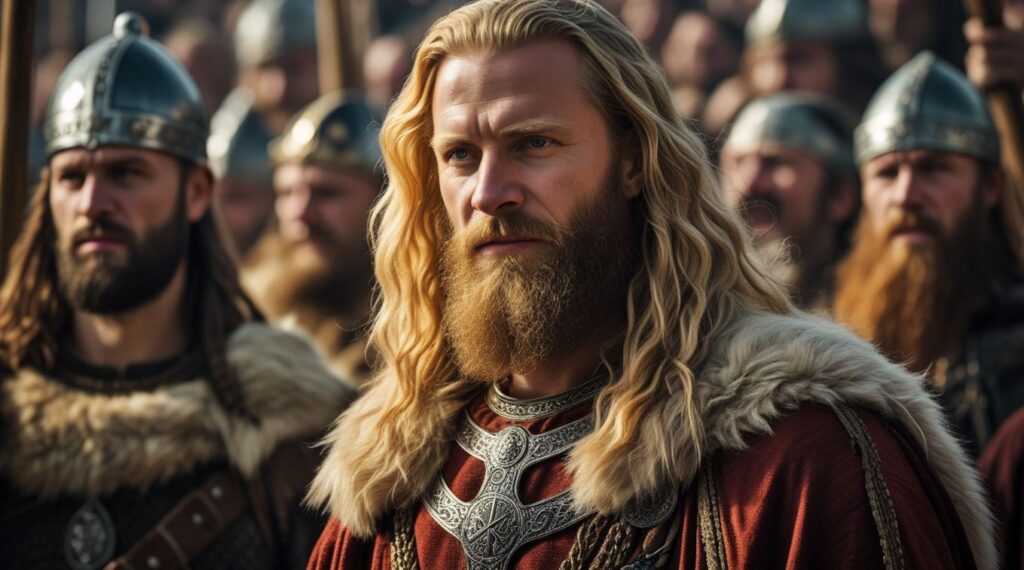Harald Hardrada, King of Norway was fifty years old in 1066. His days of eastern adventures seemed long behind him.
He had earned his fearsome reputation the hard way. Exiled as a teenager, he had served as a mercenary in Kiev and Constantinople. He had been a Varangian Guard to the Byzantine Emperor, but now he was king of Norway, locked in an endless stalemate with Denmark.
His path culminates in the dramatic events of 1066, where his bold invasion of England ended in a fierce battle at Stamford Bridge—a turning point that marked the twilight of the Viking Age.
Follow Harald Hardrada’s epic journey to his final battle at Stamford Bridge in 1066. Explore the last great Viking king’s ambitious invasion of England, his claim to the throne, and the dramatic events that ended the Viking Age forever through the eyes of this legendary Norse warrior.”
Harald Hardrada and his Unexpected Visitor
In the summer of 1066, a tall stranger walked into Harald’s hall. The sagas describe him as a big talker and warlike with an enormous English mustache. This was Tostig Godwinson, the exiled Earl of Northumbria.
Tostig burned with resentment against his brother Harold Godwinson, now King of England. He had already tried raiding English shores. Now he wanted something more ambitious: regime change.
First, Tostig had approached Sweyn of Denmark. But Sweyn refused, knowing Harald Hardrada would immediately invade Denmark if he left for England.
Tostig presented Harald Hardrada with an intriguing claim. A quarter-century earlier, Magnus of Norway and Harthacnut of Denmark had supposedly agreed that whoever died without an heir would inherit the other’s kingdoms. Magnus had been Harald’s brother and Edward the Confessor had died childless.
“Under the terms of that deal, England is yours,” Tostig would argued.
The claim was dubious at best. No written agreement existed. But it gave Harald Hardrada legal pretext for what was essentially a massive gamble.
Harald’s advisors were divided.
Some urged him forward, believing in his legendary prowess. Others warned that England was full of jeopardy.
Harald Hardrada weighed three factors. First was wealth. Norway was difficult to tax, but England was famously rich. Even a failed invasion might yield substantial Danegeld tribute.
Second was geopolitics. Harald Hardrada had always dreamed of building a North Sea empire like Canute’s. He had served great rulers in Kiev and Constantinople. Perhaps Norway felt too small a stage from what he had been used to.
Third was psychology. Harald Hardrada was a restless warrior approaching his twilight years. Like Alexander the Great, he yearned to conquer new realms. This might be his last great adventure.
Harald Hardrada’s Invasion of England
Harald Hardrada assembled 300 ships in the western fjords. With roughly 10,000 men, this was a larger force than Canute had used to conquer England in 1016.
Harald would set sail in August 1066. He first stopped at the Orkney Islands, part of his empire, to gather more men and supplies.
In mid-September, Harald made landfall on the Yorkshire coast at Riccall in North Yorkshire. This was strategic territory—the villages bore Danish names like Ormsby and Stainsby, reflecting their Viking heritage.
The locals offered no resistance. These were places with established Scandinavian trade connections. Viking ships were not entirely foreign here.
Harald then sailed to Scarborough, a larger fortified town. When the townspeople resisted, Harald made a brutal example of them. The sagas record: “The Northmen killed many people there and took all the booty they could lay hold of.”
This sent a clear message across northeastern England: submit or face destruction.
Harald then entered the Humber River. By now he had joined forces with Tostig, who brought Flemish mercenaries and possibly Scottish allies from Malcolm III.
With their combined forces, including Harald’s son Olaf and Tostig’s son Skuli, they rowed up the River Ouse toward York. This was no mere raid—Harald was serious about conquest.
Harold Hardrada Wins The Prize of York
York was the greatest prize in northern England. The former Jorvik had massive Scandinavian heritage and trading connections. It was one of only two cities comparable to London in importance.
York was defended by Earls Edwin of Mercia and Morcar of Northumbria, both in their twenties and far less battle-tested than Harald. They faced a terrible choice: stay within York’s stone walls and risk starvation, or meet the Vikings in open battle.
They chose to fight.
The Battle of Fulford
On Wednesday, September 20th, Harald and Tostig marched north along the River Ouse to Fulford, now a suburb of York. There they found their path blocked by a shield wall of about 5,000 Anglo-Saxon warriors.
The terrain created a deadly trap for both armies. The Vikings approached from higher ground to the south, giving Harald Hardrada commanding view of the battlefield.
But the Anglo-Saxons had positioned themselves with the River Ouse protecting their right flank and the Fordland marshes securing their left. If either flank collapsed, retreat would be impossible through the swampland.
Edwin and Morcar knew they faced a desperate gamble, but they also knew Harald’s army was still arriving and not yet fully deployed. They had to strike before the full Norwegian force could organize.
The English Strike First
The Anglo-Saxons charged before Harald could complete his battle formation. Morcar’s troops smashed into the Norwegian right wing—Harald’s least experienced warriors—and drove them back into the very marshlands that had seemed to protect the English flanks.
For a brief, shining moment, it seemed the young earls might achieve the impossible. Harald’s weaker troops reeled under the Anglo-Saxon assault, bodies falling in the muddy ditches.
But Harald Hardrada had not earned his fearsome reputation by yielding to initial setbacks.
Harald’s Masterstroke
Harald Hardrada had positioned his elite troops along the riverbank on his left wing. Now he ordered them forward in a devastating counter-attack while simultaneously reinforcing his battered right flank with fresh arrivals still streaming onto the battlefield.
The sight of Harald’s legendary banner “Land-Waster”—a white silk flag with a black raven—carried forward into the fray signaled the tide’s turning.
The Norwegian veterans, still fresh against the now-exhausted Anglo-Saxons who had spent their strength in the initial charge, began grinding forward. Harald’s tactical brilliance showed as he opened multiple fronts, with newly arrived warriors finding ways around the main battle to attack the Anglo-Saxon flanks.
Edwin’s soldiers defending the riverbank found themselves cut off from the main army by the marsh. Faced with encirclement, they began withdrawing toward York for a final stand. Within another hour, the remaining Anglo-Saxon positions crumbled under the relentless Norwegian pressure.
The Rout
Outnumbered, outmaneuvered, and exhausted from their initial assault, the Anglo-Saxon army shattered. Both Edwin and Morcar managed to escape the carnage, but their military power was destroyed.
The casualties were staggering—perhaps 1,650 men from both armies lay dead or dying in the muddy fields of Fulford. The mobilized power of Mercia and Northumbria had been cut to pieces.
Nothing now stood between Harald Hardrada and the prize of York.
The Submission of York
On Sunday, September 24th, York’s gates opened and the city fathers chose collaboration over destruction. Harald convened a traditional Norse assembly outside the walls and offered terms.
Rather than sacking York, Harald would make it his capital. For many citizens, this seemed preferable to Godwinson rule from distant London.
Harald demanded hostages and promised to leave some of his own men as surety.
Harald Hardrada had conquered the north and his dreams of English kingship seemed within reach. But across the country, another Harold was already force-marching 190 miles from London with grim determination, covering the distance in just one week.
The stage was set for one of medieval history’s most dramatic confrontations.
Harald Hardrada’s Final Stand: A Bridge Too Far
The morning of September 25th, 1066, dawned bright and unseasonably warm across the Yorkshire countryside.
Harald Hardrada, the towering Norwegian king whose very name struck fear across Northern Europe, woke with what must have been a satisfied smile. His audacious invasion of England had proceeded flawlessly—York had surrendered, the northern earls lay defeated, and all that remained was a simple collection of hostages and supplies at Stamford Bridge before turning south to claim the English crown.
The Fatal Decision
As Harold Hardrada divided his forces that morning—leaving a third of his 12,000 men to guard the ships at Riccall while taking 8,000 to collect the promised tribute—he made a decision that would echo through history.
The weather was uncommonly hot, and his men complained about their heavy mail shirts. Against the protests of Tostig, who warned that leaving armor behind in enemy territory was madness, Hardrada allowed his warriors to march out wearing only helmets, shields, and weapons.
The 15-mile march to Stamford Bridge took nearly five hours under the blazing sun.
Harold Hardrada’s men were in high spirits—they had crushed the only army in northern England, feasted through the night, and now faced what seemed like a ceremonial collection of tribute. No scouts were sent ahead; why would they be needed? The great Harald Hardrada had conquered far more dangerous territories with far less reason for confidence.
The Glitter of Doom
As they crossed the wooden bridge over the River Derwent, positioning themselves on the northwestern bank, a dust cloud appeared on the western horizon. At first, Hardrada and Tostig assumed it was the hostage party from York, perhaps accompanied by local dignitaries come to pay homage to their new Norwegian overlord.
But as the force drew nearer, something changed. The saga writers captured the moment with haunting precision: “their shining arms glittered like a field of broken ice.”
This was not a tribute delegation. This was an army.
The realization must have hit Harold Hardrada like a physical blow.
Harold Godwinson—the English king who was supposed to be watching the south coast for Norman invasion—had somehow covered nearly 200 miles in what seemed impossible time, gathering forces as he marched north. Now 12,000 English warriors bore down on 8,000 Norwegians who had left their armor behind.
The Last Parley
What followed was one of the most dramatic exchanges in English medieval history. A group of English riders approached under banners, their leader’s face masked behind a gilded helmet.
The English king offered his brother all of Northumbria if he would abandon the Norwegian cause. When Tostig asked what would be given to Harald Hardrada, the masked rider delivered one of history’s most memorable lines: “Seven feet of English ground, or more if he really is so much taller—but no more than that.”
A grave. He was offering the Norwegian king nothing but a grave.
Tostig, for all his faults, showed unexpected honor in that moment, refusing to betray his ally. When Harold Hardrada, who had understood none of the English exchange, asked who had spoken so eloquently, Tostig revealed it was his brother. Harold Hardrada revealed both his warrior’s appreciation for an enemy’s courage and perhaps his first inkling of the trap closing around him.
These would be the last words ever spoken between the two brothers.
The Berserker’s Last Stand
Faced with superior numbers and his men unarmored, Hardrada made the only choice available to a warrior of his reputation. He would hold the bridge—the narrow wooden crossing that represented his army’s only hope of survival until reinforcements could arrive from Riccall. But that help was hours away, if it came at all.
The battle that followed was a throwback to an earlier age of warfare—no Norman cavalry charges or innovative tactics, just the brutal clash of shield walls and the deadly mathematics of attrition.
The Norwegians formed their defensive line at the bridge’s western end, creating a bottleneck that negated the English numerical advantage.
For hours, they held.
English arrows whistled overhead, spears flew across the narrow gap, and still the Norwegian shield wall stood firm.
The sagas tell of one anonymous Norwegian warrior who single-handedly held the bridge against the entire English army, cutting down forty men with his battle-axe before finally falling to a spear thrust up through the bridge’s planks—a death both inglorious and heroic.
But even the most determined defense cannot hold forever against such odds. When the English finally broke through, surrounding the Norwegian force, Harold Hardrada faced his final moment as he had lived—with defiant courage.
According to the sagas, he cast aside his helmet and, wielding his great sword with both hands, hurled himself into the melee with a berserker’s fury. For a man who had spent his life seeking the perfect death in battle, this final charge must have felt like a homecoming. He fell, probably to an arrow in the throat, surrounded by the bodies of his enemies.
The Scale of Defeat
The numbers tell the story of the disaster. Of the 300 ships that had brought the Norwegian army to England, only 24 were needed to carry the survivors home.
Harold Hardrada’s son Olaf, who had remained with the fleet, was granted safe passage by the victorious Harold Godwinson—a final act of magnanimity from one warrior king to the family of another.
Tostig, too, lay dead among the heaped corpses by the bridge. The brother who had opened England’s door to foreign invasion had at least died with honor, refusing to abandon his ally even when offered a kingdom.
The Last Viking’s Legacy
Harald Hardrada’s death at Stamford Bridge marked more than just the end of one man’s extraordinary life—it symbolized the closing of an entire age.
The Viking era, which had terrorized and transformed Europe for three centuries, died with him on that Yorkshire bridge. Never again would dragon-prowed longships carry Scandinavian armies to foreign shores with the realistic expectation of conquest.
The irony of Hardrada’s end was breathtaking.
This man who had survived the chaos of Stiklestad, outmaneuvered Byzantine emperors, conquered cities from Sicily to the Holy Land, and earned a fortune that was legendary even by royal standards, fell victim to the most basic military error—underestimating his enemy and leaving his armor behind on a hot day.
It was, in many ways, an anticlimactic end to a legendary life.
No epic single combat with Harold Godwinson, no final speech that would echo through the halls of Valhalla—just a fatal miscalculation that turned what should have been a routine collection of tribute into a massacre.
Yet perhaps there was something fitting about it too.
Harald Hardrada had lived by the sword for over forty years, from his teenage exile to his final charge at Stamford Bridge. He had sought glory in battle across three continents and had found it repeatedly. That he should die as he had lived—weapon in hand, facing impossible odds with grim determination—was perhaps the only ending that could have satisfied such a man.
The bridge that gave the battle its name proved to be a bridge too far for the last great Viking king.
In seeking to add the crown of England to his collection of conquests, Harald Hardrada had finally met his match—not in the form of a greater warrior, but in the simple miscalculation that even legends can make.
As the survivors limped back to their ships and the long voyage home to Norway, they carried with them not just the news of defeat, but the end of an age. The Viking Age died at Stamford Bridge with Harald Hardrada, brought low not by superior arms or tactics, but by the prosaic reality that even the mightiest warriors can be undone by leaving their armor behind on a warm September morning.
In the end, perhaps that is the most human thing about Harald Hardrada’s story—that for all his legendary exploits, he remained subject to the same fatal miscalculations that bring down lesser men. The thunderbolt of the North had finally been earthed, and with him went the last great dream of Viking conquest.
Further Reading
If you enjoyed this article, you may enjoy these:
- Harald Hardrada: King of Norway
- Harald Hardrada: The Golden City and the Varangian Guard
- Harald Hardrada: From Viking Exile to Elite Byzantine Warrior
- Harald Hardrada’s Epic Journey
- Cnut the Conqueror: How a Viking Became King of England
- Blood on St. Brice’s Day: Æthelred’s Viking Massacre
- The Fear of the Year 1000: Apocalyptic Anxieties
- Tribute or Treason? Æthelred’s Gamble with the Vikings
- Kings and Queens of England Ranked from Worst to Best
- Why was the crowning of Charlemagne so important?







